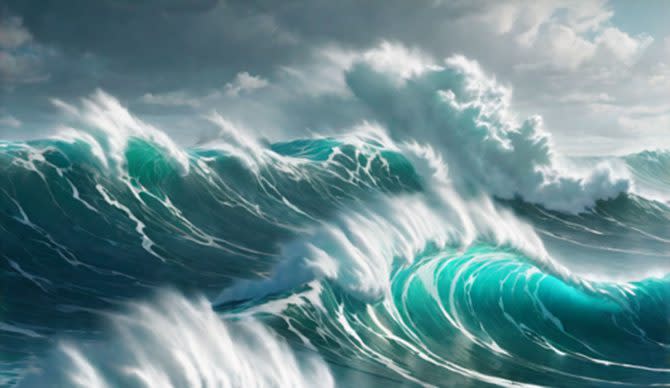New Study Finds Rogue Waves Far More Common Than Previously Thought

Rogue waves have long been the subject of sailing lore. Tales of impossibly huge waves sinking ships. Difficult to predict and rearing out of seemingly nowhere, these waves have been the subject of researchers’ interest for decades. A recent study found that they are, in fact, much more common than anyone ever initially believed.
A rogue wave is a wave that’s more than twice the height of the average waves occurring around them. According to Newswire, the first one scientists actually recorded was in 1995. Called the Draupner Wave, it rolled through off the coast of Norway. In seas that measured approximately 12 meters (a whisper under 40 feet), the Draupner Wave was 25.6 meters (84 feet).
The ocean is a big place, so keeping an eye on all parts of it at once is a little difficult. And since rogue waves are… well, rogue, it has proven nearly impossible to conduct any real research on them and what causes them to occur. But by using three-dimensional imaging of waves in the Southern Ocean, a place where some of the fiercest storms on the planet occur, a team of scientists at the University of Melbourne, working aboard the South African icebreaker S.A. Agulhas-II, were able to add just a little bit more information to what we’ve been able to collect since the Draupner Wave was recorded.
“Despite observations, we still don’t know how often rogue waves occur, or if we can predict them,” wrote a Professor in Ocean Engineering at the University of Melbourne. “A record of a rogue wave doesn’t include specific features that distinguish the sea around it, so we can’t make comparisons or predict the conditions needed.”
According to Toffoli, there are several things that must come together to create a rogue wave. One of the most important of those things is a single source of energy created by the overlapping of many waves in the same place at the same time. All the energy from those single waves is concentrated into one singularly tall wave that, if it’s tall enough, meets the requirements to officially become a rogue wave.
“Under consistent ocean conditions, rogue waves generated this way may occur once every two days at a set location,” Toffoli explained. “But the ocean is dynamic, so conditions are rarely consistent for long – making it less likely for rogue waves to occur. The overlap of waves may be minimal or non-existent even during prolonged and intense storms.”
Another important element of the formation of a rogue wave is strong winds. That may seem obvious, as waves are formed by wind moving over water, but when conditions for the birth of a rogue wave are already occurring, strong winds can add to them. Wind, however, has been seldom considered in rogue wave research.
“Wind prompts ocean waves to grow progressively higher, longer and faster,” Toffoli wrote. “During this stage, waves are ‘young’ and hungry for wind input. When waves go faster than wind, they stop being accelerated by it and reach a ‘mature’ stage of full development. Through this process, the wind creates a chaotic situation where waves of different dimensions and directions coexist. Our recent observations show that unique sea conditions with rogue waves can arise during the ‘young’ stage – when waves are particularly responsive to the wind. This suggests wind parameters could be the missing link.”
Another factor when considering how rogue waves are formed is a mechanism called self-amplification. In short, it’s an exchange of energy between waves where one wave grows larger at the expense of another.
“While self-amplification manifests as whitecaps – frothy, aerated crests of choppy waves – until now there has been no evidence it can make rogue waves more likely in the ocean,” Toffoli said. “Recent experiments suggest wind can make extreme events like rogue waves more common. But this aspect has not been thoroughly explored.”
The method Tiffoli and his team used to search the Southern Ocean for rogue waves mimicked the human eye. A series of sensors recorded sequences of simultaneous images, while an algorithm matched pairs of them to “reconstruct the three-dimensional depths – the wavy surface..”
As the S.A. Agulhas-II headed into some of the many storms that batter the Southern Ocean at any given time, its sensors recorded data during different stages of the growth of the waves around the vessel. From the earliest stages of the young waves whipped up by the wind, to the older stages of waves so big they’re barely influenced by it, researchers took in an enormous amount of information. And what they found surprised them. Instead of being rare occurrences akin to a unicorn, rogue waves were happening far more frequently than anyone thought. It did prove a theory, though.
“Our results show young waves display signs of self-amplification and an increased likelihood of rogue waves,” Toffoli wrote. “We recorded waves twice as high as their neighbors once every six hours. This mirrors what lab models have reported: sea conditions theoretically more prone to self-amplification would produce more rogue waves. In contrast, mature seas don’t show an increased probability of rogue waves. We detected none under those conditions.”
The post New Study Finds Rogue Waves Far More Common Than Previously Thought first appeared on The Inertia.

